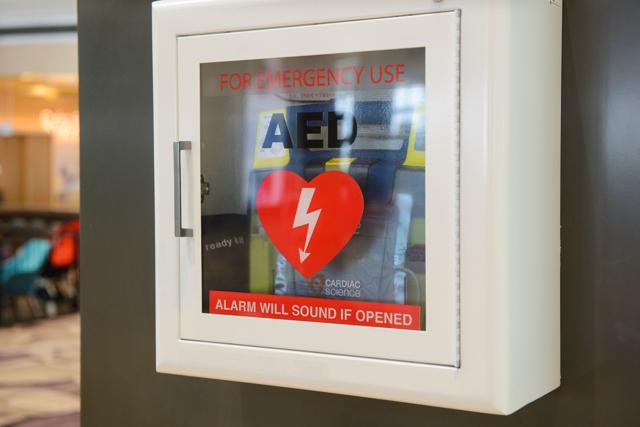
Automated External Defibrillator(AED) on the wall
Rappahannock County gathering data on lifesaving cardiac devices
It’s almost two years since Keir Whitson came minutes away from dying.
Back in July 2022, the Rappahannock County supervisor and his family were visiting Whitson’s mother in Wisconsin when he had a near fatal heart attack. While on the phone with an emergency dispatcher, his wife Susan began performing CPR.
That kept Whitson’s circulation going and gave him more time until an emergency crew arrived within five minutes. Susan’s response and their proximity to a rescue squad likely saved his life. If CPR isn’t started within two minutes, severe and permanent brain damage can occur after nine minutes. After 10 minutes, the chance of survival is low.
Whitson knows how lucky he was in his race against the clock. He also knows his chance of survival would have been considerably slimmer in a rural community like Rappahannock County.
‘A doctor may say remarkable – I would say miraculous’
Supervisor Keir Whitson suffered a catastrophic heart attack last year and lived to tell of it
So he’s using his own traumatic experience, combined with his position in the local government, to set in motion a plan to improve the odds for local residents. The June 25 meeting of the Public Safety Committee (originally scheduled for this week) will focus on identifying and responding to cardiac emergencies.
The first step, Whitson said, is to determine where automated external defibrillators (AEDs) are in the county. That’s not as simple as it may sound since some are purchased by private businesses, organizations and churches, and their locations don’t have to be reported. Darren Stevens, the county’s Emergency Services Coordinator, is trying to track down where they are.
“It’s been a little bit of a challenge,” he said. “I’ve had to reach out to businesses. Same with churches. I’m trying to see what’s out there.”
A few are known to be in public buildings, such as the county courthouse, the two public schools and The Washington School building, and Whitson’s goal is for the county to augment the existing AEDs with more in public locations, such as post offices and the county park.
“Over the years, these defibrillators have been scattered around really without a plan,” said Whitson. Going forward, he’d like to see the county take the lead in shaping a larger, more structured defibrillator network.
Lifesaving devices
AEDs are battery-operated portable devices that analyze a person’s heart rhythm and deliver an electrical shock to restore a normal rhythm during cardiac arrest. They use electrodes and conductive gel to pass a brief electrical current through the heart, allowing the body’s natural pacemaker to reset. While AEDs cannot restart a heart that has flatlined, they can make a critical difference for someone who has gone into arrest.
An AED costs about $2,000, and the county has been exploring grants and private donations to cover the cost of what it would add to the network. Stevens pointed out that the devices are most useful in places where people tend to congregate, such as the Town of Washington and Sperryville or population clusters, such as Chester Gap.
Whitson said that it also may be possible to map AED locations for the Sheriff Office’s dispatchers so they could tell volunteer responders where they can pick one up on their way to a cardiac emergency instead of first stopping at their station to grab a device.
Last year, 24 cardiac emergency calls came into county dispatchers, plus another 49 related to chest pains, according to Lt. Janie Jenkins in the Sheriff’s Office. The previous year, the total calls were 45 and 32 respectively. .
Whitson also mentioned a mobile app called PulsePoint Respond to which people with CPR training can subscribe. It alerts them to cardiac arrest emergencies nearby, enabling them to potentially get to the victim before emergency responders arrive. But, according to Stevens, the app directs users only to emergencies in public or commercial locations, not in private homes.
Need for more CPR training
The other key component in providing emergency care for Rappahannock’s aging population, said Whitson, is having more people trained in performing CPR. Stevens said the county is stepping up its efforts to make local groups and organizations aware of training sessions taught by Kathryn Waters, the recruitment and retention coordinator for the county’s Office of Emergency Management.
He said he’s optimistic that the Rappahannock community will respond by requesting training that could help save lives.
“It’s amazing what people will do here,” said Stevens. “I’m amazed at how much groups like the Lions Club and Rapp at Home do here.”
Rapp at Home plans to soon begin setting up CPR training sessions, according to Joyce Wenger, the nonprofit’s president.
For Whitson, who knows firsthand what a critical difference timely chest compressions can make, that’s a big step forward in developing what’s known as a “chain of survival.”
“We’re looking at what we can do in our community to ensure that all aspects of dealing with a medical emergency are lined up in such a way that the patient benefits,” he said.




